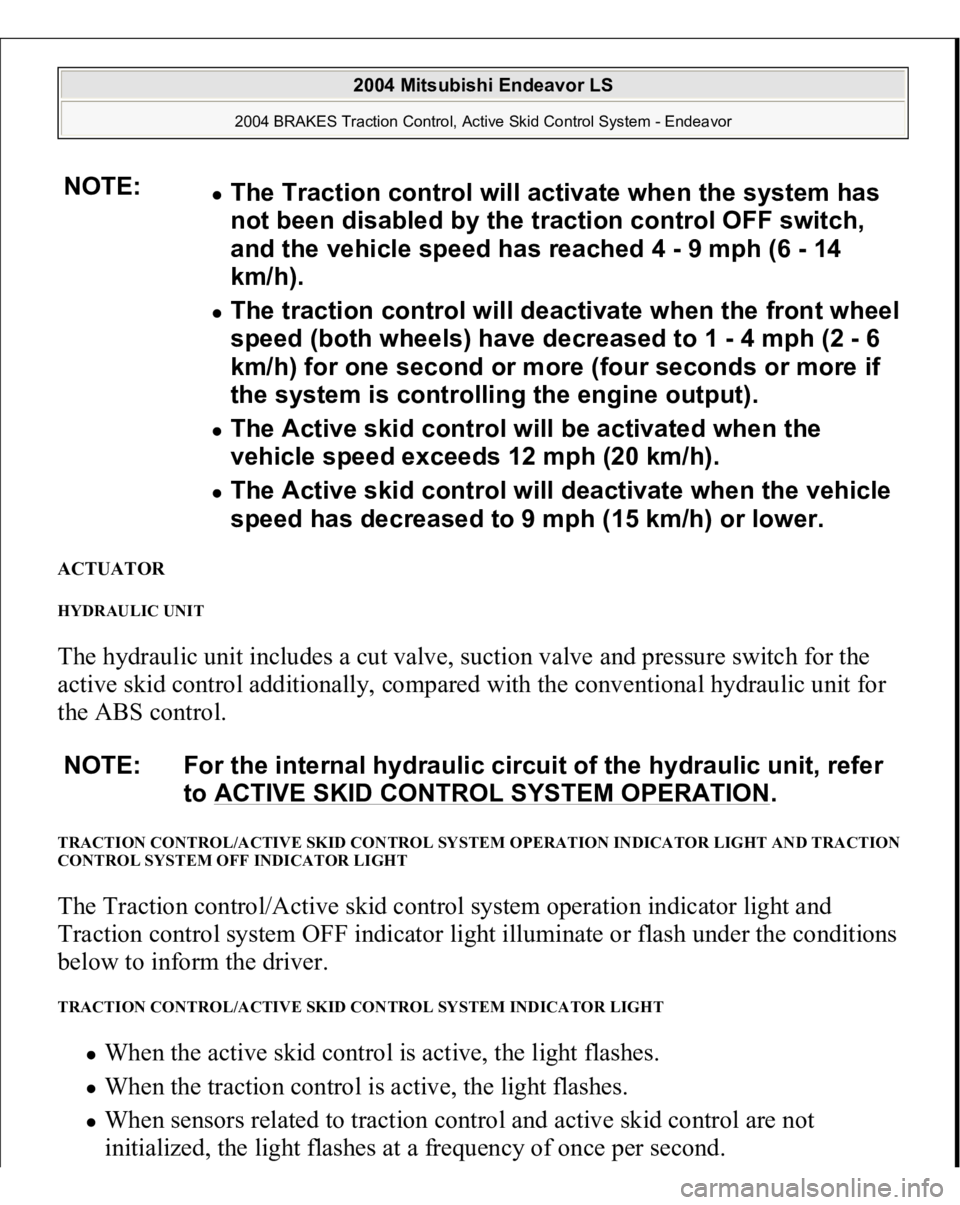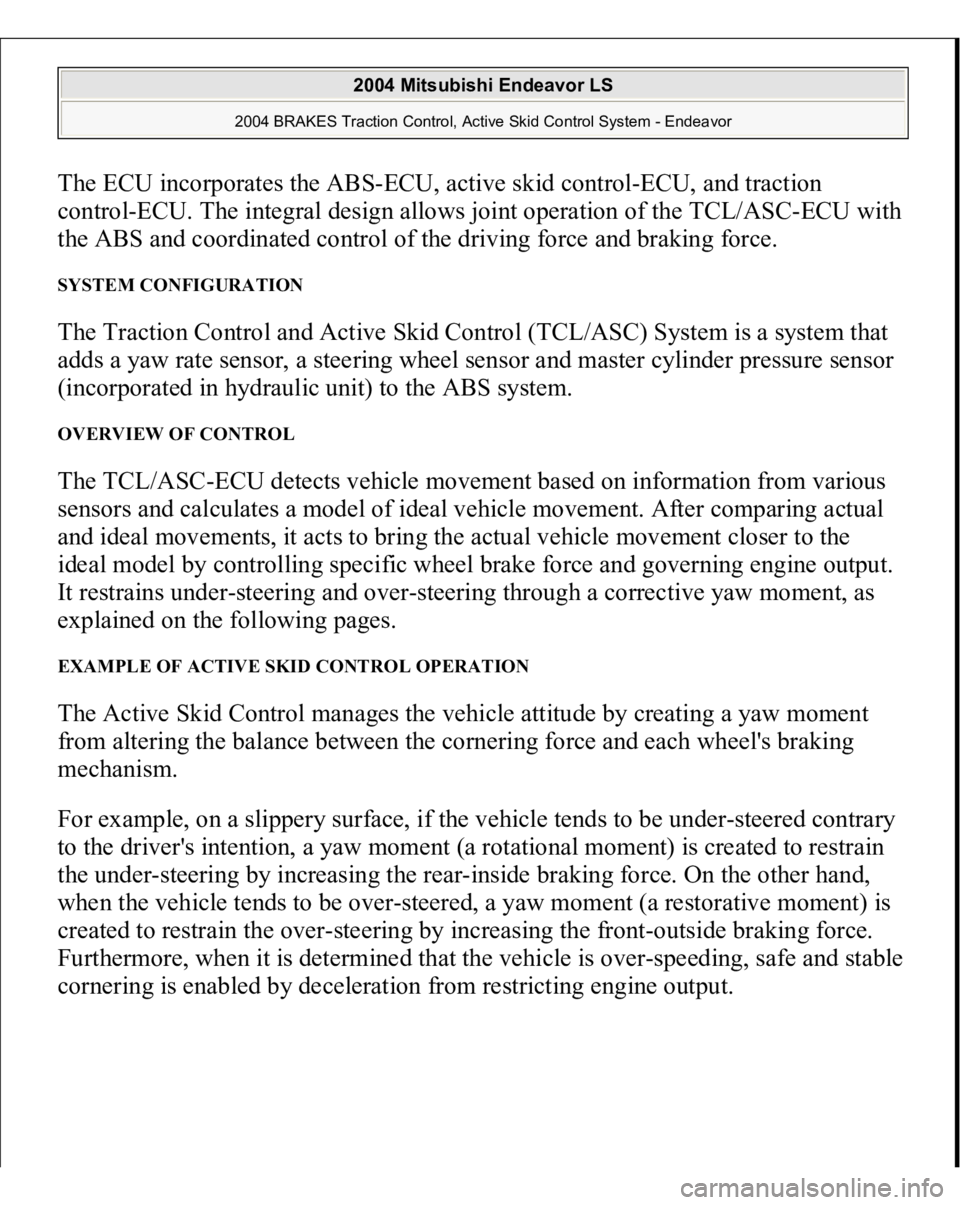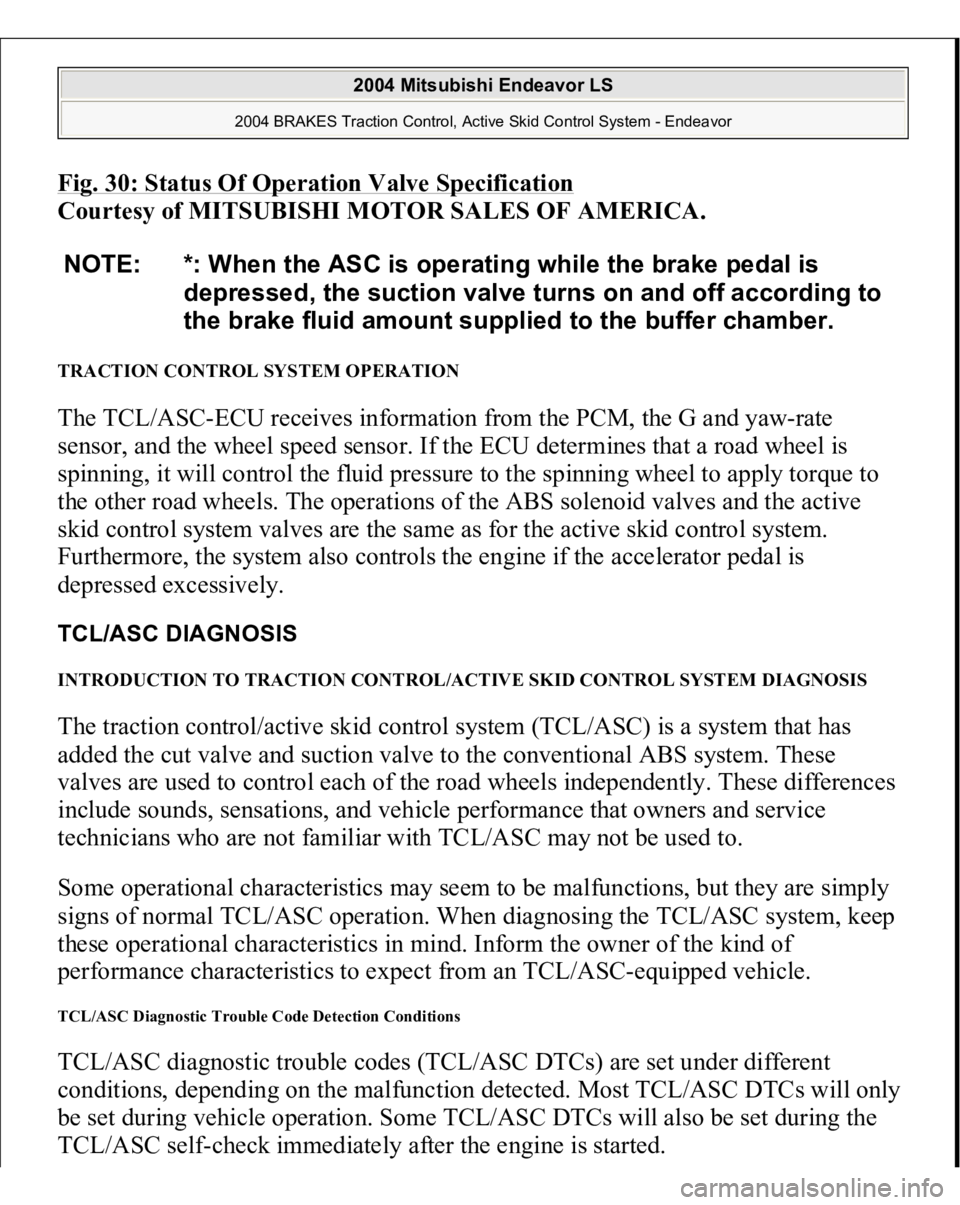Page 2877 of 3870
< Mating Mark Alignment
>
1. Turn the clock spring clockwise fully. Then turn it back approximately 3-
3/4 turns counterclockwise to align the mating marks.
2. Turn the front wheels to the straight-ahead position. Then install the clock
spring to the column switch.
Fig. 35: Aligning Mating Marks Of Clock Spring
Courtesy of MITSUBISHI MOTOR SALES OF AMERICA.
2. On vehicles with ASC, align the mating marks of the steering wheel sensor as
follows.
CAUTION: Ensure that the steering wheel sensor's mating
marks are properly aligned. If not, the steering
wheel sensor could be damaged.
2004 Mitsubishi Endeavor LS
2004 STEERING Power Steering - Endeavor
Page 2878 of 3870
< Mating Mark Alignment
>
1. Turn the steering wheel sensor clockwise fully. Then turn it back
approximately 2-3/4 turns counterclockwise to align the mating marks.
2. Align the mating marks on the clock spring and the steering wheel sensor,
and install the steering wheel sensor to the column switch assembly.
3. Connect the steering wheel sensor connector.
Fig. 36: Aligning Mating Marks On Clock Spring
Courtesy of MITSUBISHI MOTOR SALES OF AMERICA.
DISASSEMBLY AND ASSEMBLY
WARNING:
Do not move the tilt lever from the lock position
2004 Mitsubishi Endeavor LS
2004 STEERING Power Steering - Endeavor
Page 3113 of 3870
Courtesy of MITSUBISHI MOTOR SALES OF AMERICA
.
STEERING WHEEL SENSOR
This sensor is mounted behind the column switch, and detects the steering
wheel position. The steering wheel sensor has a self-diagnosis function and a memory
function. If the diagnosis function finds a trouble, it sends a DTC code to the
TCL/ASC-ECU. Then the ECU will illuminate the TCL/ASC indicator light.
Fig. 4: Identifying Steering Wheel Sensor
Courtesy of MITSUBISHI MOTOR SALES OF AMERICA.
TRACTION CONTROL OFF SWITCH
NOTE: For the details of the DTC codes, refer to DIAGNOSTIC
TROUBLE CODE CHART
.
2004 Mitsubishi Endeavor LS
2004 BRAKES Traction Control, Active Skid Control System - Endeavor
Page 3115 of 3870

ACTUATOR HYDRAULIC UNIT The hydraulic unit includes a cut valve, suction valve and pressure switch for the
active skid control additionally, compared with the conventional hydraulic unit for
the ABS control. TRACTION CONTROL/ACTIVE SKID CONTROL SYSTEM OPERATION INDICATOR LIGHT AND TRACTION
CONTROL SYSTEM OFF INDICATOR LIGHT The Traction control/Active skid control system operation indicator light and
Traction control system OFF indicator light illuminate or flash under the conditions
below to inform the driver. TRACTION CONTROL/ACTIVE SKID CONTROL SYSTEM INDICATOR LIGHT
When the active skid control is active, the light flashes. When the traction control is active, the light flashes. When sensors related to traction control and active skid control are not
initialized, the li
ght flashes at a fre
quenc
y of once
per second.
NOTE:
The Traction control will activate when the system has
not been disabled by the traction control OFF switch,
and the vehicle speed has reached 4 - 9 mph (6 - 14
km/h). The traction control will deactivate when the front wheel
speed (both wheels) have decreased to 1 - 4 mph (2 - 6
km/h) for one second or more (four seconds or more if
the system is controlling the engine output). The Active skid control will be activated when the
vehicle speed exceeds 12 mph (20 km/h). The Active skid control will deactivate when the vehicle
speed has decreased to 9 mph (15 km/h) or lower.
NOTE: For the internal hydraulic circuit of the hydraulic unit, refer
to ACTIVE SKID CONTROL SYSTEM OPERATION
.
2004 Mitsubishi Endeavor LS
2004 BRAKES Traction Control, Active Skid Control System - Endeavor
Page 3117 of 3870

The ECU incorporates the ABS-ECU, active skid control-ECU, and traction
control-ECU. The integral design allows joint operation of the TCL/ASC-ECU with
the ABS and coordinated control of the driving force and braking force. SYSTEM CONFIGURATION The Traction Control and Active Skid Control (TCL/ASC) System is a system that
adds a yaw rate sensor, a steering wheel sensor and master cylinder pressure sensor
(incorporated in hydraulic unit) to the ABS system. OVERVIEW OF CONTROL The TCL/ASC-ECU detects vehicle movement based on information from various
sensors and calculates a model of ideal vehicle movement. After comparing actual
and ideal movements, it acts to bring the actual vehicle movement closer to the
ideal model by controlling specific wheel brake force and governing engine output.
It restrains under-steering and over-steering through a corrective yaw moment, as
explained on the following pages. EXAMPLE OF ACTIVE SKID CONTROL OPERATION The Active Skid Control manages the vehicle attitude by creating a yaw moment
from altering the balance between the cornering force and each wheel's braking
mechanism.
For example, on a slippery surface, if the vehicle tends to be under-steered contrary
to the driver's intention, a yaw moment (a rotational moment) is created to restrain
the under-steering by increasing the rear-inside braking force. On the other hand,
when the vehicle tends to be over-steered, a yaw moment (a restorative moment) is
created to restrain the over-steering by increasing the front-outside braking force.
Furthermore, when it is determined that the vehicle is over-speeding, safe and stable
cornerin
g is enabled b
y deceleration from restrictin
g en
gine out
put.
2004 Mitsubishi Endeavor LS
2004 BRAKES Traction Control, Active Skid Control System - Endeavor
Page 3120 of 3870

Fig. 10: Identifying Joint Control Specification
s
Courtesy of MITSUBISHI MOTOR SALES OF AMERICA.
EXAMPLE OF OPERATION OF TRACTION CONTROL The Traction Control prevents drive force loss during slipping of the drive wheels
by automatically applying the brakes and sending engine torque reduction signal to
the PCM when the drive wheels slip or when driving on partly low-friction
surfaces. FAIL-SAFE AND DIAGNOSTIC FUNCTIONS The TCL/ASC-ECU regularly monitors input and out put signals. If an error is
detected in the system, the ECU sends a fail signal and the TCL/ASC indicator light
is illuminated or blinks. Various controls are processed depending on the cause of
malfunction as shown below. When the ABS system fails, the TCL/ASC system is
also suspended. However, when the TCL/ASC system fails, no other systems are
suspended. The appropriate indicator lights are illuminated/flashed.
The TCL/ASC-ECU includes the following functions to make system inspection
easier.
Diagnostic trouble code Display Data list Actuator test
All of the above operations can be carried out using scan tool MB991958.
ACTIVE SKID CONTROL SYSTEM OPERATION The TCL/ASC-ECU receives information from the PCM, the steering sensor, the G
and yaw-rate sensor and the wheel speed sensor. If the ECU determines that the
vehicle is tending to oversteer or understeer, it sends signals to the active skid
control system valves and the ABS solenoid valves to increase the fluid pressure to
the wheels.
The system closes the cut valve to shut the fluid channel to the suction valve, and
activates the
pum
p motor. The brake fluid, which is
pum
ped throu
gh the h
ydraulic
2004 Mitsubishi Endeavor LS
2004 BRAKES Traction Control, Active Skid Control System - Endeavor
Page 3134 of 3870

Fig. 30: Status Of Operation Valve Specificatio
n
Courtesy of MITSUBISHI MOTOR SALES OF AMERICA.
TRACTION CONTROL SYSTEM OPERATION The TCL/ASC-ECU receives information from the PCM, the G and yaw-rate
sensor, and the wheel speed sensor. If the ECU determines that a road wheel is
spinning, it will control the fluid pressure to the spinning wheel to apply torque to
the other road wheels. The operations of the ABS solenoid valves and the active
skid control system valves are the same as for the active skid control system.
Furthermore, the system also controls the engine if the accelerator pedal is
depressed excessively. TCL/ASC DIAGNOSIS INTRODUCTION TO TRACTION CONTROL/ACTIVE SKID CONTROL SYSTEM DIAGNOSIS The traction control/active skid control system (TCL/ASC) is a system that has
added the cut valve and suction valve to the conventional ABS system. These
valves are used to control each of the road wheels independently. These differences
include sounds, sensations, and vehicle performance that owners and service
technicians who are not familiar with TCL/ASC may not be used to.
Some operational characteristics may seem to be malfunctions, but they are simply
signs of normal TCL/ASC operation. When diagnosing the TCL/ASC system, keep
these operational characteristics in mind. Inform the owner of the kind of
performance characteristics to expect from an TCL/ASC-equipped vehicle. TCL/ASC Diagnostic Trouble Code Detection Conditions TCL/ASC diagnostic trouble codes (TCL/ASC DTCs) are set under different
conditions, depending on the malfunction detected. Most TCL/ASC DTCs will only
be set during vehicle operation. Some TCL/ASC DTCs will also be set during the
TCL/ASC self-check immediatel
y after the en
gine is started.
NOTE: *: When the ASC is operating while the brake pedal is
depressed, the suction valve turns on and off according to
the brake fluid amount supplied to the buffer chamber.
2004 Mitsubishi Endeavor LS
2004 BRAKES Traction Control, Active Skid Control System - Endeavor
Page 3149 of 3870
Fig. 38: Diagnostic Trouble Code Chart (3 Of 3)
Courtesy of MITSUBISHI MOTOR SALES OF AMERICA.
< STEERING WHEEL SENSOR DTC >
2004 Mitsubishi Endeavor LS
2004 BRAKES Traction Control, Active Skid Control System - Endeavor